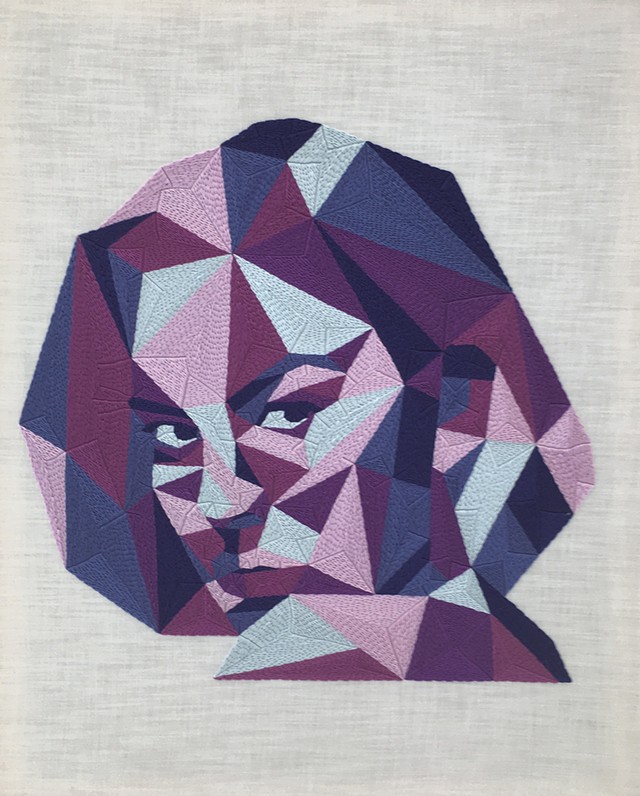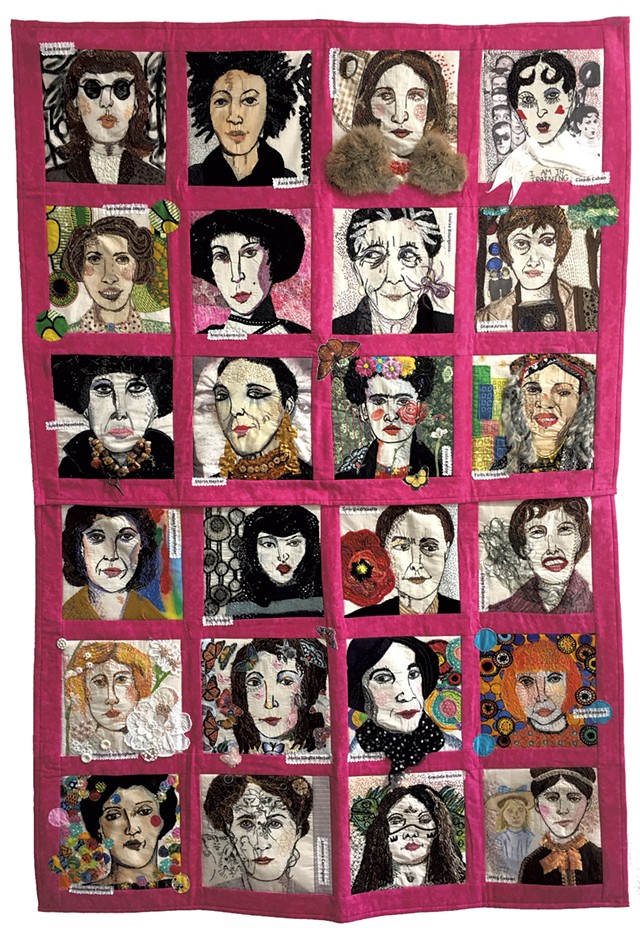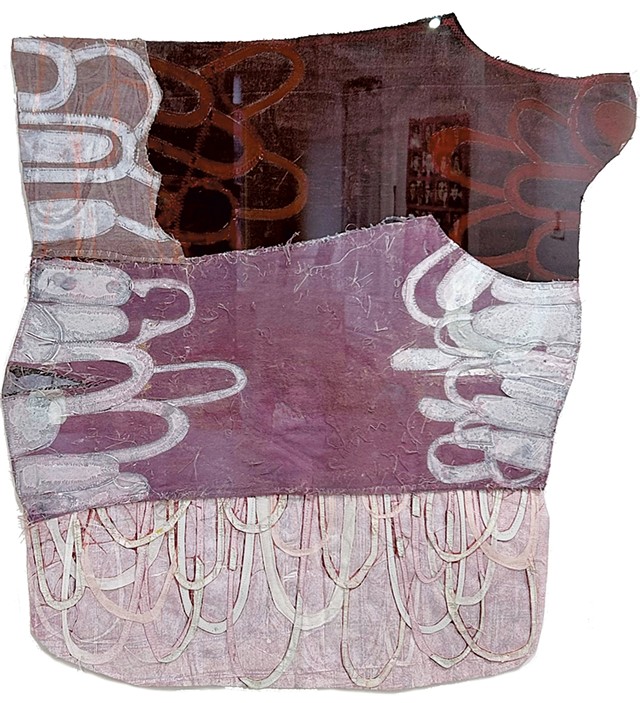
- Courtesy Of Athena Tasiopoulos
- "Weather Any Storm" by Elizabeth Fram
Recent and upcoming museum exhibitions in the U.S. and London suggest that fiber arts are having a moment — again. Artworks employing, based on or mimicking textiles have appeared throughout recorded history. Consider the woven-gold thread used in royal clothing and jewelry in ancient Egypt. Or the 11th-century Bayeux Tapestry. Who would not declare that a fine piece of art? But in recent centuries, art critics and historians have been judgier — let's just call it misogynistic — about the implementation of needle and thread in artwork.
Well, enough of that. Just as collecting institutions are reckoning with colonialist views and practices, the patriarchal adjudication of what may be considered art has frayed. What was once dismissed as craft, decoration or just homey women's work has been elevated. Moreover, a younger generation of artists has embraced both a DIY/maker aesthetic and the eco-conscious mantra of "reuse, reduce, recycle."
With this backdrop, Barre's Studio Place Arts has mounted "Up and Down, In and Out: Embroidery and Its Kin." The first part of that title might reflect not only the action of stitching but its uneven reception in the art world. The curators — Cabot artist Janet Van Fleet and SPA executive director Sue Higby — have compiled an impressive variety of works by 34 artists from Vermont and beyond. All but one of the artists are women, and their ages span decades.
Among the works that feature traditional embroidery, a framed rectangle of cloth near the gallery's front door immediately catches the eye. But its subject is unexpected. Kimberly O'Haver, who lives in New York City, stitched "Woody Guthrie Dyslexia Piece" for Dyslexia Awareness Month, according to an accompanying description. "It is a rendering of the first time that my son, Tivadar, who has a reading and writing learning difference, willingly put pencil to paper and wrote his version of the words to his favorite song," O'Haver explains.
That song was "This Land Is Your Land." She stitched Tivadar's singular spelling in black thread, along with an acoustic guitar, a bee and a flowering plant. "For me, this is a beautiful keepsake of his educational journey," O'Haver concludes.
Two small embroidery "drawings" on unframed linen, by Claudia Renfro of Pound Ridge, N.Y., are hilariously twisted. In "Courtship," a pair of cartoony figures could be a comment on a frightful dating scene. Both are clad in saucy lingerie and chunky high heels. One has a dog face and exposed breasts; the other is vaguely avian but holds a cigarette between thick lips. Oh, and both are armless. Renfro's website is populated by a menagerie of bizarre characters that, she writes, "may showcase the good, the bad, the ugly and the absurd." Her stitching, however, is precise.
On her website, Elizabeth Fram of Waterbury Center declares, "I stitch and I draw, each practice informing the other." Her pieces in the SPA exhibit demonstrate just that. Fram's four watercolor-and-graphite portraits are enhanced with hash-mark stitches; the thread, which she carefully calibrated to the hues of the painting beneath it, adds texture and subtle sheen. In "The Alchemist," the background is augmented with tiny buttons in a range of greens (The subject of this portrait is Van Fleet, who sometimes uses vintage buttons in her work.)
Fram pierced the paper so delicately that no holes are evident, which is easier said than done. The eloquent images themselves — each the face of an elder female Vermont artist — are both somber and soulful.

- Courtesy
- "Ur Joking" by Delaney Conner
New York City-based Delaney Conner, trained in architecture and interior design, takes a modern, angular approach to what she dubs "painting with textiles." Using punch-needle embroidery, Conner creates faces and figures from geometric shapes, each of which is a plane of solid color. Her sole piece in "Up and Down" is a woman's face in blues and purples titled "Ur Joking." Casting a sidelong glance over her shoulder at the viewer, the woman looks seductive even if she does suggest a puzzle.
Conner's reductive compositions somehow call to mind contemporary works by the renowned Gee's Bend quilters of Alabama; piecing together abstract shapes in vibrant colors, both deliver a visual punch.
Quilting is one fabric-based art form not represented in the SPA exhibition, but Leslie Pearson's banners are nearly as large as blankets. The multimedia artist, who lives in Fayetteville, N.C., sent three works from her series "Vignettes of a Family." Pearson writes in her artist statement that she is "drawn to things that have layers of history." Her wall hangings combine vintage photographs printed on fabric with elements of stitching: lines, cursive text and blossoms. The sepia tone and early 20th-century images instantly convey a uniquely American narrative.

- Courtesy
- "Women Artists" by Shirley Ritter
Shirley Ritter references history, too — that is, women's art history. In a pair of wall hangings titled simply "Women Artists," the Southern California textile and book artist borrows quilting techniques — appliqué, machine stitching and hand embroidery — to create 24 vivacious portraits of well-known artists. Compiling them in square blocks like a group Zoom call, Ritter added dimensional details including fake fur, neck scarves and jewelry and bordered each image in Barbie pink.
She also added name tags, though artists such as Yayoi Kusama, Frida Kahlo and Louise Nevelson are easily recognizable. A viewer could spend a lot of time taking in all the nuances that help identify these women and their oeuvres.
Sharon Webster's visual storytelling is more graphic and immediate: Over three X-rays of her own body parts — spine, right hand and right foot — she sewed zigzags of colored thread. For the Burlington artist, the concept of stitching is literal. "'My Stitched Spine' is a meditation on both the vulnerability and the durability of the human body," she writes in a statement. "I imagined the threads as a way to apply healing and agency."
The very words associated with textile arts — weaving, sewing, mending, repairing, stitching — can serve as metaphors for things that need fixing or healing. But sometimes, they might embed a caution. Two examples: White threads dangle from Cabot-based Rosalind Daniels' black-and-white photograph, "Democracy, Hanging by a Thread." The machine-embroidered felt piece "homesafe," by Boston artist Charlie Dov Schön, depicts house keys hanging from a thong, revealed by a pulled-back skirt. "This work is equal parts humor and horror," she writes, "holding both the absurdity and the reality of what it means to get home safe." By which she means for women.

- Courtesy
- "Pants 2" and "Well Traveled Flannel" by Mackenzie Kovaka
Barre-based maker Mackenzie Kovaka could be considered a fabric activist, if you see her "Pants 2" and "Well Traveled Flannel" as a response to the climate crisis. In the middle of the gallery, a makeshift mannequin strikes a pose in Kovaka's thrifted, cleverly patched and embroidered jeans and plaid shirt. The artist makes a convincing argument for slow fashion.

- Courtesy
- "Jean" by Susan Smereka
Sewing is just one of myriad techniques in Susan Smereka's mixed-media collages. The Burlington artist has an unerring aptitude for cutting, rearranging and stitching together her monotypes, as well as vintage manufactured materials, in abstract compositions. "Jean," one of Smereka's two entries in the SPA show, combines shapes in shades of rust and purple that are printed with distinctive looping patterns. Though asymmetrical, the piece looks like a shield, which in turn calls to mind a certain 15th-century French heroine.
Stitching alone won't save the world, but the collective creatives in "Up and Down" may needle viewers to get out the sewing basket.










Comments
Comments are closed.
From 2014-2020, Seven Days allowed readers to comment on all stories posted on our website. While we've appreciated the suggestions and insights, right now Seven Days is prioritizing our core mission — producing high-quality, responsible local journalism — over moderating online debates between readers.
To criticize, correct or praise our reporting, please send us a letter to the editor or send us a tip. We’ll check it out and report the results.
Online comments may return when we have better tech tools for managing them. Thanks for reading.